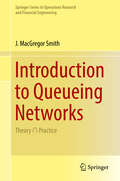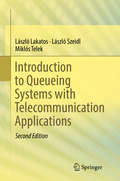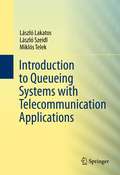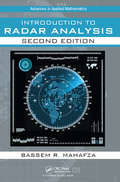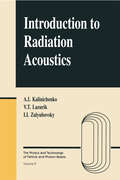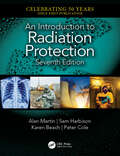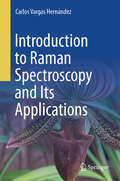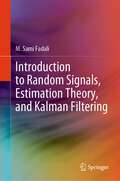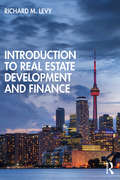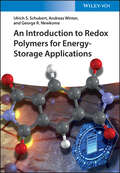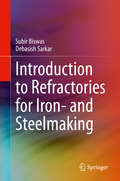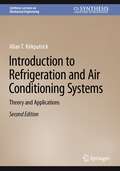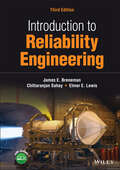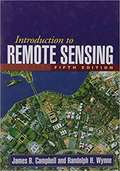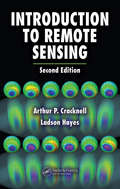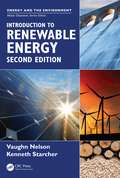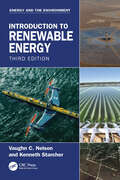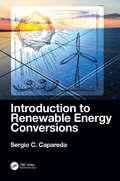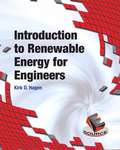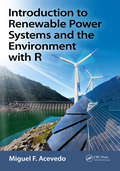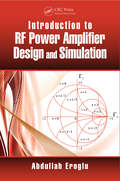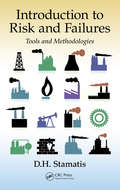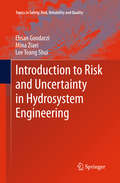- Table View
- List View
Introduction to Queueing Networks: Theory ∩ Practice (Springer Series in Operations Research and Financial Engineering)
by J. MacGregor SmithThe book examines the performance and optimization of systems where queueing and congestion are important constructs. Both finite and infinite queueing systems are examined. Many examples and case studies are utilized to indicate the breadth and depth of the queueing systems and their range of applicability. Blocking of these processes is very important and the book shows how to deal with this problem in an effective way and not only compute the performance measures of throughput, cycle times, and WIP but also to optimize the resources within these systems. The book is aimed at advanced undergraduate, graduate, and professionals and academics interested in network design, queueing performance models and their optimization. It assumes that the audience is fairly sophisticated in their mathematical understanding, although the explanations of the topics within the book are fairly detailed.
Introduction to Queueing Systems with Telecommunication Applications
by László Lakatos László Szeidl Miklós TelekThe book is the extended and revised version of the 1st edition and is composed of two main parts: mathematical background and queueing systems with applications. The mathematical background is a self-containing introduction to the stochastic processes of the later studied queueing systems. It starts with a quick introduction to probability theory and stochastic processes and continues with chapters on Markov chains and regenerative processes. More recent advances of queueing systems are based on phase type distributions, Markov arrival processes and quasy birth death processes, which are introduced in the last chapter of the first part.The second part is devoted to queueing models and their applications. After the introduction of the basic Markovian (from M/M/1 to M/M/1//N) and non-Markovian (M/G/1, G/M/1) queueing systems, a chapter presents the analysis of queues with phase type distributions, Markov arrival processes (from PH/M/1 to MAP/PH/1/K). The next chapter presents the classical queueing network results and the rest of this part is devoted to the application examples. There are queueing models for bandwidth charing with different traffic classes, slotted multiplexers, media access protocols like Aloha and IEEE 802.11b, priority systems and retrial systems.An appendix supplements the technical content with Laplace and z transformation rules, Bessel functions and a list of notations. The book contains examples and exercises throughout and could be used for graduate students in engineering, mathematics and sciences.Reviews of first edition:"The organization of the book is such that queueing models are viewed as special cases of more general stochastic processes, such as birth-death or semi-Markov processes. … this book is a valuable addition to the queuing literature and provides instructors with a viable alternative for a textbook to be used in a one- or two-semester course on queueing models, at the upper undergraduate or beginning graduate levels."Charles Knessl, SIAM Review, Vol. 56 (1), March, 2014
Introduction to Queueing Systems with Telecommunication Applications
by Laszlo Lakatos Miklos Telek Laszlo SzeidlThe book is composed of two main parts: mathematical background and queueing systems with applications. The mathematical background is a self containing introduction to the stochastic processes of the later studies queueing systems. It starts with a quick introduction to probability theory and stochastic processes and continues with chapters on Markov chains and regenerative processes. More recent advances of queueing systems are based on phase type distributions, Markov arrival processes and quasy birth death processes, which are introduced in the last chapter of the first part. The second part is devoted to queueing models and their applications. After the introduction of the basic Markovian (from M/M/1 to M/M/1//N) and non-Markovian (M/G/1, G/M/1) queueing systems, a chapter presents the analysis of queues with phase type distributions, Markov arrival processes (from PH/M/1 to MAP/PH/1/K). The next chapter presents the classical queueing network results and the rest of this part is devoted to the application examples. There are queueing models for bandwidth charing with different traffic classes, slotted multiplexers, ATM switches, media access protocols like Aloha and IEEE 802.11b, priority systems and retrial systems. An appendix supplements the technical content with Laplace and z transformation rules, Bessel functions and a list of notations. The book contains examples and exercises throughout and could be used for graduate students in engineering, mathematics and sciences.
Introduction to Radar Analysis (Advances in Applied Mathematics)
by Bassem R. MahafzaIntroduction to Radar Analysis, Second Edition is a major revision of the popular textbook. It is written within the context of communication theory as well as the theory of signals and noise. By emphasizing principles and fundamentals, the textbook serves as a vital source for students and engineers. Part I bridges the gap between communication, signal analysis, and radar. Topics include modulation techniques and associated Continuous Wave (CW) and pulsed radar systems. Part II is devoted to radar signal processing and pulse compression techniques. Part III presents special topics in radar systems including radar detection, radar clutter, target tracking, phased arrays, and Synthetic Aperture Radar (SAR). Many new exercise are included and the author provides comprehensive easy-to-follow mathematical derivations of all key equations and formulas. The author has worked extensively for the U.S. Army, the U.S. Space and Missile Command, and other military agencies. This is not just a textbook for senior level and graduates students, but a valuable tool for practicing radar engineers. Features Authored by a leading industry radar professional. Comprehensive up-to-date coverage of radar systems analysis issues. Easy to follow mathematical derivations of all equations and formulas Numerous graphical plots and table format outputs. One part of the book is dedicated to radar waveforms and radar signal processing.
Introduction to Radiation Acoustics (The Physics and Technology of Particle and Photon Beams)
by Alexander Kalinichenko Valentine T. Lazurik Illya I. ZalyubovskyIn this volume, the author explains a generalized theory of radiation acoustic phenomena. This concise and comprehensive introduction to the field of radiation acoustics considers the nonlinear and non-thermal mechanisms of sound generation as well as the fundamental equations of radiation acoustics. The author also explores topics beyond theory and postulates some applications of radiation acoustic effects. Introduction to Radiation Acoustics is ideal for graduate students and specialists in the fields of accelerator techniques, acoustics, radiotherapeutics, and elementary particle physics.
An Introduction to Radiation Protection
by Peter Cole Alan Martin Sam Harbison Karen BeachThis highly-readable account of the nature of the hazards presented by ionizing radiation and the methods of protection is an ideal introductory text for those new to the field, and for the non-specialist. The seventh edition continues to cover the technical principles underlying the control of radiation hazards, radiation detection and measurement and the biological effects of radiation, followed by a consideration of industry-specific radiation protection issues. Further specialised topics include risk assessment, waste management and decommissioning, radiological emergencies, relevant legislation and organizational issues and, new to this edition, environmental radiation protection.
Introduction to Radio Engineering
by Nathan Blaunstein Christos Christodoulou Mikhail SergeevThe book introduces the basic foundations of high mathematics and vector algebra. Then, it explains the basic aspects of classical electrodynamics and electromagnetism. Based on such knowledge readers investigate various radio propagation problems related to guiding structures connecting electronic devices with antenna terminals placed at the different radar systems. It explains the role of antennas in process of transmission of radio signals between the terminals. Finally, it shows the relation between the main operational charactistics of each kind of radar and the corresponding knowledge obtained from the previous chapters.
Introduction to Raman Spectroscopy and Its Applications
by Carlos Vargas HernándezThe book explores theoretical foundations of Raman spectroscopy, looking into key concepts such as parameters, perturbation theories, normal vibration modes, and the application of group theory to specific structures. It also examines modifications of the Raman technique, particularly in the Surface Enhanced Raman Scattering (SERS) modality. Practical aspects of both Raman and SERS spectroscopy are covered in detail. Additionally, the book presents the characteristic Raman spectra of various materials measured by the author, along with a basic analysis of their molecular structures. This comprehensive approach ensures that readers gain a thorough understanding of both the theoretical and practical elements of Raman spectroscopy. Developed from the author's notes, research, and over a decade of teaching the Raman spectroscopy course, this book underscores the vital importance of spectroscopies in both academia and industry. These techniques are invaluable in the analytical field, offering powerful tools for the study and diagnosis of materials due to their capabilities for both quantitative and qualitative applications. Optical spectroscopies, inherently non-invasive, have gained popularity due to advancements in monochromatic sources and high-performance, high-resolution detectors, resulting in more versatile and portable instruments. Additionally, new methodologies for data acquisition and statistical analysis have been developed, reducing acquisition time and increasing the signal-to-noise ratio. Innovations in acquisition techniques, such as SERS, enable the acquisition of high-quality spectra from sample concentrations far below those required by conventional methods. The book offers a comprehensive introduction to one of the fastest-growing optical techniques, driven by advancements in optoelectronic and control devices. Aimed at final-year students in science and engineering, the text features clear mathematical explanations and explicit steps to help readers grasp the scope and applicability of the mathematical concepts involved. It serves as a foundational guide, equipping readers with the essential knowledge needed to tackle more complex models found in specialized literature.
Introduction to Random Signals, Estimation Theory, and Kalman Filtering
by M. Sami FadaliThis book provides first-year graduate engineering students and practicing engineers with a solid introduction to random signals and estimation. It includes a statistical background that is often omitted in other textbooks but is essential for a clear understanding of estimators and their properties. The book emphasizes applicability rather than mathematical theory. It includes many examples and exercises to demonstrate and learn the theory that makes extensive use of MATLAB and its toolboxes. Although there are several excellent books on random signals and Kalman filtering, this book fulfills the need for a book that is suitable for a single-semester course that covers both random signals and Kalman filters and is used for a two-semester course for students that need remedial background. For students interested in more advanced studies in the area, the book provides a bridge between typical undergraduate engineering education and more advanced graduate-level courses.
Introduction to Real Estate Development and Finance
by Richard M. LevyThis book provides readers with a basic understanding of the principles that underlie real estate development. A brief historical overview and an introduction to basic principles are followed by examples from practice. Case studies focus on how cities change and respond to the economic, technological, social, and political forces that shape urban development in North America. It is important to have a framework for understanding the risks and rewards in real estate investing. In measuring return, consideration must be given to both investment appreciation and the cash flow generated over the life of a project. In addition, metrics are presented that can be useful in assessing the financial feasibility of a real estate development proposal. This book also provides an overview of the forces of supply and demand that gauge the potential market for a new project. In determining the size of “residual demand”, estimates for population growth, family formation, and new development are important. All development projects fall under the auspices of one or several jurisdictions. Though every jurisdiction has different rules and procedures, basic knowledge of the planning process is critical to the success of all development projects regardless of location. Furthermore, all projects have a legal component. Basic issues of land ownership, property rights, property transfer, and land registration are reviewed, all of which need to be considered when a property is sold or purchased. This book also provides a primary on the design and construction process. In constructing a building, a team of experts is first required to design the architectural, structural, and heating, ventilation, and air conditioning (HVAC) systems for a building. An overview is provided of each building system: wood, concrete, and steel. Critical to a successful real estate development, project management principles for the processes of design, bidding, and construction are explored, with close attention given to budgeting, scheduling, and resource management. Essential reading for anyone involved in the development of our built environment, this is a must-read introduction for students and professionals in architecture, urban planning, engineering or real estate seeking an approachable and broad view of real estate development and finance.
An Introduction to Redox Polymers for Energy-Storage Applications
by Ulrich S. Schubert Andreas Winter George R. NewkomeAn Introduction to Redox Polymers for Energy-Storage Applications Presents a well-founded introduction to the field or Redox Polymers, with didactical features like summary boxes and a Q&A sections An Introduction to Redox Polymers for Energy-Storage Applications discusses fundamental aspects related to polymer-based batteries, such as types of batteries, their historic development, design and synthesis criteria of the active material, and summarizes the various types of redox polymers and their applications. Each chapter contains learning objectives, summary boxes, and questions to allow for efficient exam preparation. In An Introduction to Redox Polymers for Energy-Storage Applications, readers will find detailed information on: Fundamental aspects of redox-active polymers, along with their historical classification, taking the key applications of the materials into account Energy-storage devices, containing polymers as the electrode active materials, and specific material requirements for the desired applications Classification of redox-active polymers, e.g., according to the nature of the actual redox-active moieties, their backbone structure, or topology Electrical conductivity of conjugated polymers, covering their most prominent representatives (polyaniline, polypyrrole, polythiophene, and polyacetylene) An Introduction to Redox Polymers for Energy-Storage Applications also covers the synthesis and applications of these materials, making it an excellent book for graduates, PhD students, and professionals who are starting in this field.
Introduction to Refractories for Iron- and Steelmaking
by Subir Biswas Debasish SarkarThis book promotes understanding of the raw material selection, refractory design, tailor-made refractory developments, refractory properties, and methods of application. It provides a complete analysis of modern iron and steel refractories. It describes the daily demands on modern refractories and describes how these needs can be addressed or improved upon to help achieve the cleanest and largest yields of iron and steel. The text contains end-of-chapter summaries to help reinforce difficult concepts. It also includes problems at the end of chapters to confirm the reader's understanding of topics such as hoop stress modeling in steel ladle and vessels, establishment of thermal gradient modeling , refractory corrosion dynamics, calculation of Blast furnace trough dimension based on thermal modeling, to name a few. Led by editors with backgrounds in both academia and industry, this book can be used in college courses, as a reference for industry professionals, and as an introduction to the technology for those making the transition to industry.Stands as a comprehensive introduction to the science and technology of modern steel and iron-making refractories that examines the processes, construction, and potential improvement of refractory performance and sustainability;Serves as a versatile resource appropriate for all levels, from the student to industry novices to professionals;Reinforces difficult-to-grasp concepts with end-of-chapter summaries;Maximizes reader understanding of key topics, such as refractory selection for steel ladle and vessels, and their corrosion dynamics, with real life problems.
Introduction to Refrigeration and Air Conditioning Systems: Theory and Applications (Synthesis Lectures on Mechanical Engineering)
by Allan T. KirkpatrickThis second edition builds on the foundation established by the previous first edition published in 2017. The first edition covered background information, description, and analysis of four major cooling system technologies - vapor compression cooling, evaporative cooling, absorption cooling, and gas cooling. The second edition has been expanded to include increased coverage of cooling system refrigerants, fluid mechanics, heat transfer, and building cooling loads. With increasing climate change due to the buildup of greenhouse gas emissions in the atmosphere, there has been a worldwide impetus to transition to cooling systems and refrigerants that have a low or even zero global warming potential. The text is written as a tutorial for engineering students and practicing engineers who want to become more familiar with the performance of refrigeration and air conditioning systems. The goals are to familiarize the reader with cooling technology nomenclature and provide insight into how refrigeration and air conditioning systems can be modeled and analyzed. Emphasis is placed on constructing idealized thermodynamic cycles to represent actual physical situations in cooling systems. The book contains numerous practical examples to show how one can calculate the performance of cooling system components. By becoming familiar with the analyses presented in the examples, one can gain a feel for representative values of the various thermal and mechanical parameters that characterize cooling systems.
Introduction to Reliability Engineering
by James E. Breneman Chittaranjan Sahay Elmer E. LewisIntroduction to Reliability Engineering A complete revision of the classic text on reliability engineering, written by an expanded author team with increased industry perspective Introduction to Reliability Engineering provides a thorough and well-balanced overview of the fundamental aspects of reliability engineering and describes the role of probability and statistical analysis in predicting and evaluating reliability in a range of engineering applications. Covering both foundational theory and real-world practice, this classic textbook helps students of any engineering discipline understand key probability concepts, random variables and their use in reliability, Weibull analysis, system safety analysis, reliability and environmental stress testing, redundancy, failure interactions, and more. Extensively revised to meet the needs of today’s students, the Third Edition fully reflects current industrial practices and provides a wealth of new examples and problems that now require the use of statistical software for both simulation and analysis of data. A brand-new chapter examines Failure Modes and Effects Analysis (FMEA) and the Reliability Testing chapter has been greatly expanded, while new and expanded sections cover topics such as applied probability, probability plotting with software, the Monte Carlo simulation, and reliability and safety risk. Throughout the text, increased emphasis is placed on the Weibull distribution and its use in reliability engineering. Presenting students with an interdisciplinary perspective on reliability engineering, this textbook: Presents a clear and accessible introduction to reliability engineering that assumes no prior background knowledge of statistics and probability Teaches students how to solve problems involving reliability data analysis using software including Minitab and Excel Features new and updated examples, exercises, and problems sets drawn from a variety of engineering fields Includes several useful appendices, worked examples, answers to selected exercises, and a companion website Introduction to Reliability Engineering, Third Edition remains the perfect textbook for both advanced undergraduate and graduate students in all areas of engineering and manufacturing technology.
Introduction To Remote Sensing
by James B. Campbell Randolph H. WynneA leading text for undergraduate- and graduate-level courses, this book introduces widely used forms of remote sensing imagery and their applications in plant sciences, hydrology, earth sciences, and land use analysis. The text provides comprehensive coverage of principal topics and serves as a framework for organizing the vast amount of remote sensing information available on the Web. Including case studies and review questions, the book's four sections and 21 chapters are carefully designed as independent units that instructors can select from as needed for their courses. Illustrations include 29 color plates and over 400 black-and-white figures. New to This Edition *Reflects significant technological and methodological advances. *Chapter on aerial photography now emphasizes digital rather than analog systems. *Updated discussions of accuracy assessment, multitemporal change detection, and digital preprocessing. *Links to recommended online videos and tutorials.
Introduction to Remote Sensing
by Arthur P. CracknellIntroduction to Remote Sensing, Second Edition provides a full and authoritative introduction for scientists who need to know the scope, potential, and limitations of remote sensing. Suitable for students and professionals with some background in the physical sciences, this book comprehensively surveys the basic principles behind remote sensing physics, techniques, and technology. It features updated and expanded material, including greater coverage of applications from across the earth, environmental, atmospheric, and oceanographic sciences. Illustrated with remotely sensed color images from satellites and aircraft, it also outlines data acquisition, interpretation, and analysis.
Introduction to Renewable Energy (Energy and the Environment)
by Vaughn C. Nelson Kenneth L. StarcherIntroduction to Renewable Energy, Second Edition covers the fundamentals of renewable energy and serves as a resource to undergraduates in renewable energy courses, non-specialists within the energy industries, or anyone working to support the successful implementation of renewable energy.The second edition discusses developments that have occurred
Introduction to Renewable Energy (Energy and the Environment)
by Vaughn C. Nelson Kenneth L. StarcherIntroduction to Renewable Energy, Third Edition covers the fundamentals of renewable energy and serves as a resource to undergraduates in renewable energy courses, nonspecialists within the energy industries, or anyone working to support the successful implementation of renewable energy. This revised edition discusses developments that have occurred since the publication of the previous edition and considers the growing environmental impact of human activity on planet Earth. Dedicated to converging science and technology in a way that ensures a sustainable future, this book outlines the basics of renewable energy and focuses on current and developing policies that support the shift to renewable energy. New in the third edition, the book addresses bioenergy, energy balance, biodiesel, and photovoltaic applications, and includes an all-new chapter addressing climate change. ·Revised throughout and includes an all-new chapter on climate change. Includes color images throughout for this new edition. Adds revised end-of-chapter problems, and a solutions manual and PowerPoint slides for instructors. Includes several appendices: mathematics, exponential growth, lifetime of finite resource, order of magnitude estimates, and conversions.
Introduction to Renewable Energy Conversions
by Sergio C. CaparedaIntroduction to Renewable Energy Conversions examines all the major renewable energy conversion technologies with the goal of enabling readers to formulate realistic resource assessments. The text provides step-by-step procedures for assessing renewable energy options and then moves to the design of appropriate renewable energy strategies. The goal is for future engineers to learn the process of making resource estimates through the introduction of more than 140 solved problems and over 165 engineering related equations. More than 120 figures and numerous tables explain each renewable energy conversion type. A solutions manual, PowerPoint slides, and lab exercises are available for instructors. Key Features Covers all major types of renewable energy with comparisons for use in energy systems Builds skills for evaluating energy usage versus environmental hazards and climate change factors Presents and explains the key engineering equations used to design renewable energy systems Uses a practical approach to design and analyze renewable energy conversions Offers a solutions manual, PowerPoint slides, and lab activity plans for instructors
Introduction To Renewable Energy For Engineers
by Kirk D. HagenIntroduction to Renewable Energy for Engineers is intended for beginning engineering students and students in other fields of study who want to learn the fundamental engineering principles of renewable energy. The primary focus of this book is the application of renewable energy to electrical power generation. As each renewable energy technology is explained, the student is shown how to do a basic energy analysis of the corresponding power-generation system. <p><p> Following an introductory chapter that covers the main types of renewable energy, the basics of energy and power calculations, and the fundamental economics of renewable energy systems, the book devotes a separate chapter to each renewable energy type: solar, wind, hydro, geothermal, marine, and biomass.
Introduction to Renewable Power Systems and the Environment with R
by Miguel F. AcevedoThis textbook introduces the fundamentals of renewable electrical power systems examining their direct relationships with the environment. It covers conventional power systems and opportunities for increased efficiencies and friendlier environmental interactions. While presenting state-of-the-art technology, the author uses a practical interdisciplinary approach explaining electrical, thermodynamics, and environmental topics within every chapter. This approach allows students to feel comfortable moving across these disciplines. The added value are the examples of software programs using open source systems which serve as learning tools for the concepts and techniques described in the book.
An Introduction to Reservoir Simulation Using MATLAB/GNU Octave: User Guide for the MATLAB Reservoir Simulation Toolbox (MRST)
by Knut-Andreas LieThis book provides a self-contained introduction to the simulation of flow and transport in porous media, written by a developer of numerical methods. The reader will learn how to implement reservoir simulation models and computational algorithms in a robust and efficient manner. The book contains a large number of numerical examples, all fully equipped with online code and data, allowing the reader to reproduce results, and use them as a starting point for their own work. All of the examples in the book are based on the MATLAB Reservoir Simulation Toolbox (MRST), an open-source toolbox popular popularity in both academic institutions and the petroleum industry. The book can also be seen as a user guide to the MRST software. It will prove invaluable for researchers, professionals and advanced students using reservoir simulation methods. This title is also available as Open Access on Cambridge Core.
Introduction to RF Power Amplifier Design and Simulation
by Abdullah ErogluIntroduction to RF Power Amplifier Design and Simulation fills a gap in the existing literature by providing step-by-step guidance for the design of radio frequency (RF) power amplifiers, from analytical formulation to simulation, implementation, and measurement. Featuring numerous illustrations and examples of real-world engineering applications, this book: Gives an overview of intermodulation and elaborates on the difference between linear and nonlinear amplifiers Describes the high-frequency model and transient characteristics of metal–oxide–semiconductor field-effect transistors Details active device modeling techniques for transistors and parasitic extraction methods for active devices Explores network and scattering parameters, resonators, matching networks, and tools such as the Smith chart Covers power-sensing devices including four-port directional couplers and new types of reflectometers Presents RF filter designs for power amplifiers as well as application examples of special filter types Demonstrates the use of computer-aided design (CAD) tools, implementing systematic design techniques Blending theory with practice, Introduction to RF Power Amplifier Design and Simulation supplies engineers, researchers, and RF/microwave engineering students with a valuable resource for the creation of efficient, better-performing, low-profile, high-power RF amplifiers.
Introduction to Risk and Failures: Tools and Methodologies
by D. H. StamatisRisk is everywhere, in everything we do. Realizing this fact, we all must try to understand this "risk" and if possible to minimize it. This book expands the conversation beyond failure mode and effects analysis (FMEA) techniques. While FMEA is indeed a powerful tool to forecast failures for both design and processes, it is missing methods for considering safety issues, catastrophic events, and their consequences. This new book focuses on risk and HAZOP as they relate to major catastrophic events, safety, and risk.
Introduction to Risk and Uncertainty in Hydrosystem Engineering
by Ehsan Goodarzi Mina Ziaei Lee Teang ShuiWater engineers require knowledge of stochastic, frequency concepts, uncertainty analysis, risk assessment, and the processes that predict unexpected events. This book presents the basics of stochastic, risk and uncertainty analysis, and random sampling techniques in conjunction with straightforward examples which are solved step by step. In addition, appropriate Excel functions are included as an alternative to solve the examples, and two real case studies is presented in the last chapters of book.
